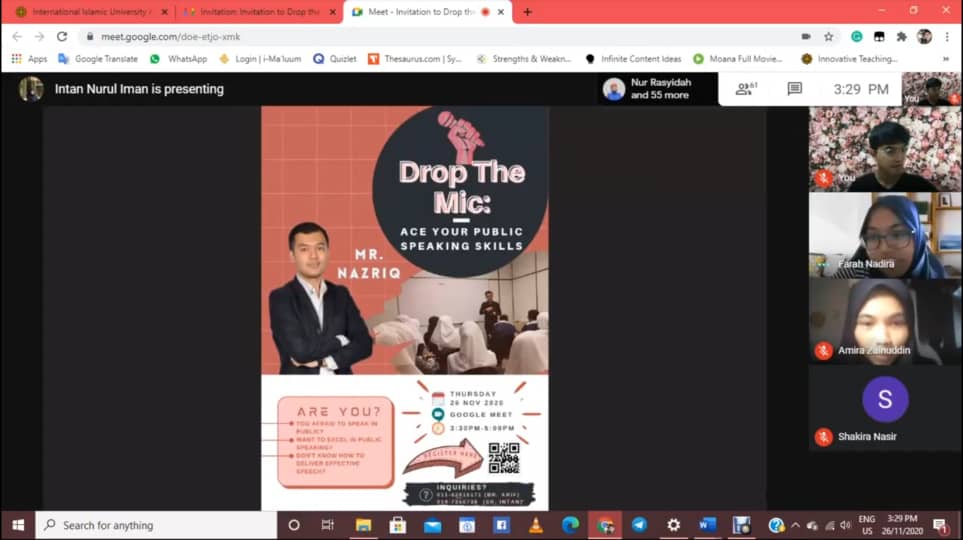By Athira ABD Latiff
GOMBAK, 28 November 2020: Public speaking is already a challenge on its own and facing the 0fears that follows is no less challenging.
The common concerns shared among the students are the lack of confidence, feeling nervous and inability to apply suitable language.
Speaking during a webinar conducted last Thursday (26 November), IIUMs very own Centre for Foundation Studies (CFS)’s lecturer and YouTuber, Mr. Mohd Nazriq Noor Ahmad, highlighted the importance of self-trust throughout the process of public speaking and provided straightforward steps to ace ones public speaking.
That is to say that the speaker kick-started the session by focusing on students concerns emphasising the struggles and solutions to overcome the problem.
To gain confidence, Nazriq said, “It all begins with believing in yourself and that nobody can truly bring you down except you yourself.”
He pointed out the common tendency of undermining oneself excessively. Rather than undermining oneself, he encouraged the participants to think otherwise and start trusting themselves that they are capable of achieving the possible.
As public speakers, it is normal to feel a sense of nervousness and having butterflies in the stomach when placed in a situation with many people as the centre of attention. “Whats not normal is not feeling any sense of nervousness or whatsoever,” Nazriq said.
He highlighted that adrenaline rushes within us when we are nervous and gives a boost of energy to do either better, or to completely shut down. What most people are unaware of is how to channel that energy.
Different types of nervous patterns for public speaking have different ways to deal with them, he said.
Some examples provided by Nazriq are: hands trembling, one might want to hold any object to keep themselves calm. When legs feel weak, one might want to sit down or wear heavier shoes that literally makes you feel grounded.
Nazriq shared that in terms of language application, it is completely fine to have a Malay accent. He claimed that one doesnt need to have an American or British accent to get their point across. Rather, accent reflects the identity and personality of the speaker in leaving an impression.
Subsequently, he also provided guidelines and tips to structure a speech in order to enhance confidence in oneself involving crafting introduction, delivering the message and crafting conclusion as shown below.
Crafting introduction
Nazriq stated that the introduction is the most important part of the speech because a good introduction makes the audience engaged. It also leaves a good first impression of yourself.
Step 1: Attention grabber
Techniques:
- Say something startling or new intriguing information. A good startling statement is something relatable and genuine.
- Ask questions by making the audience think and feel.
- Tell a concise and elaborated story. It is effective, but dont make it the main focus of the public speaking.
- Telling jokes must be relatable and repeatable.
- Personal references that engage the audiences with imagination, but keep in mind that some audience prefer having the answers on the spot.
- Quote someone.
- Be dramatic, act out – perform an action to a certain limit
Step 2: Make your speech relevant
- Present things that connect to the concerns of the audience. Have it relatable and agreeable.
Step 3: Make them believe you by establishing credibility
- Show that you care and that your are able to apply and connect things people will most likely trust you.
- Pay close attention to sources and researching. False information is common nowadays, always fact check things.
- Personal experiences can be used only if its proper experience. Not all experiences are important.
Delivering the message
Making sure the message gets delivered is as important as the delivery of ones voice and tone as well.
Tips:
- Be natural and spontaneous. Most of the time people wont know what were talking about, so they wouldnt know if we forgot whats supposed to be said.
- Be expressive.
- Speak clearly. Ensure that your volume is clear as well, not only the enunciations.
- Speak expressively.
- Maintain eye contact. Allow the audience to concentrate.
- Using both body and facial expressions. The kind of expression made can alter the tone of what is being said. Thus, changing the intended meaning.
Crafting the conclusion
The goal is to summarise points and to provide a sense of closure. In doing so, one must show facts that things have truly ended, in other words, using a clincher. You can also invite the audience to join the cause, initiating an action from them.
Nazriq concluded the webinar with a reminder to the 70 participants that it is important to focus on improving oneself, judge no one and that even though familiarising ourselves to a script, it doesnt necessarily mean we have to follow it.
He remarked that public speakers should not confine themselves to a script as life itself is unscripted.***
